You can use the SAP TM embedded in SAP S/4HANA for your essential to advanced shipment activities. It also supports integration with other SAP ERP solutions making the SAP implementation and migration process very effective tool to manage your transportation planning.
This article will introduce SAP TM’s capabilities and its use case. You will also get familiarized with the application and explore the deployment options of SAP TM in S4/HANA.
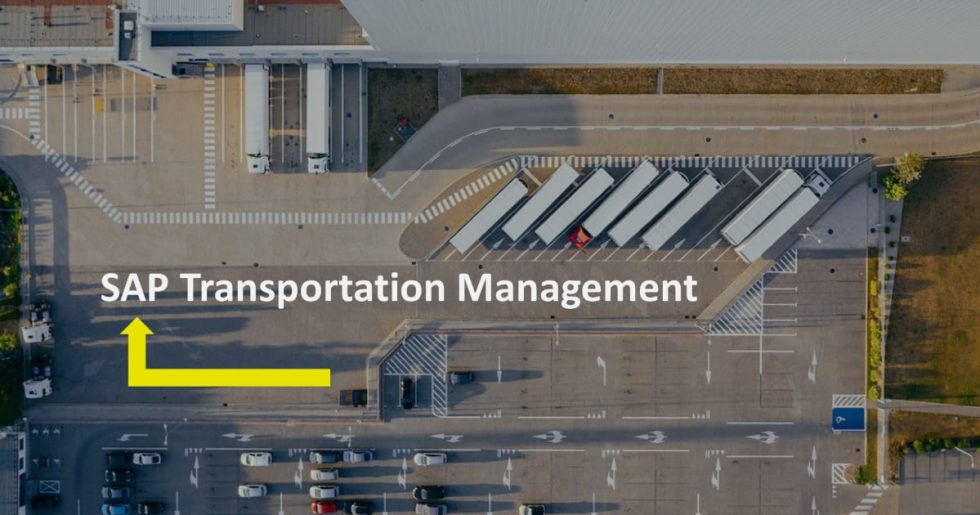
Table of Contents
What is TM in SAP?
SAP TM or SAP Transportation Management is a solution powered by SAP S/4HANA to organize and track all of your transportation and shipment tasks. The solution lets you optimize and track your transportation capabilities, including route, floor, and destination planning, while managing your logistics holistically. Moreover, it seamlessly integrates with all of your business processes as part of SAP’s Supply Chain Execution (SCE) platform and gives you instant visibility of your domestic and international transportation and shipment status.
SAP TM Background
For transportation and logistics management, SAP has long offered a logistics execution module known as LE-TRA to be used with SAP ERP R/3. However, LE-TRA did not have more advanced features such as combining inbound and outbound shipments or capacity planning despite having basic shipment capabilities.
To make transportation and shipment management more dynamic and in line with the modern industry practices, SAP introduced the SAP TM module, initially a stand-alone transportation and logistics management solution. However, since 2017, SAP TM is also available as an embedded solution within SAP S/4HANA, with basic and advanced licensing options to match your needs.
Business Challenges with Transportation
Before learning about the functionalities of SAP TM, let’s get an idea about the critical business challenges related to modern-day transportation management and why supply chain visibility is crucial. Some of the challenges are related to:
- Full utilization of vehicle’s capacity.
- Route planning.
- Trackability of shipment.
- Rising transportation costs due to fuel price, wages, and other factors.
- On-time delivery.
- Shipper management.
- High amount of paperwork and lack of transparency in cost calculations.
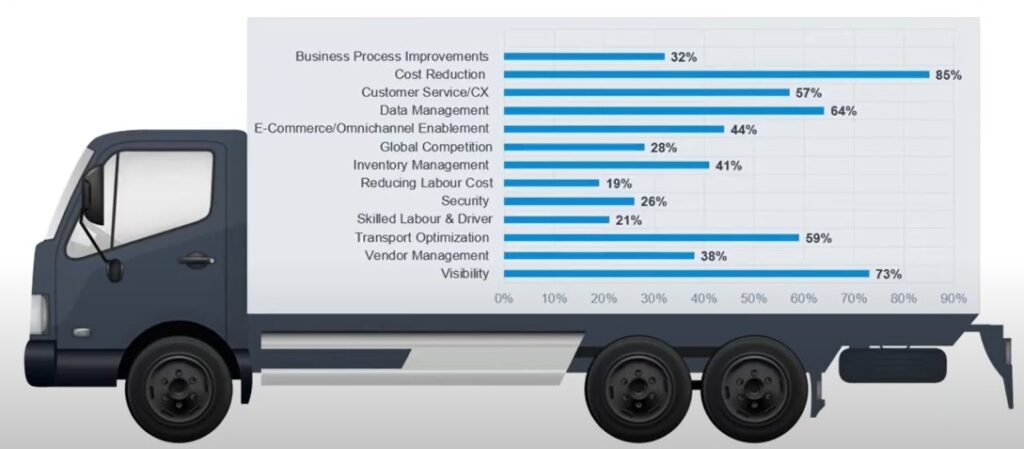
You can mitigate all of these challenges and reduce your transportation cost with enhanced, real-time visibility of your supply chain. Below are some of the generic visibility requirements for your supply chain across all industries.
- Events Visibility
- Planned and unexpected activities.
- Productivity and efficiency.
- Accuracy (On-time delivery).
- Cost and Revenue
- Cost per product.
- Cost per shipment.
- Cost and revenue analysis.
- Extra payment for drivers and handlers.
- Inter-company billing and payments.
- Logistical
- Vehicle capacity utilization.
- Batch visibility.
- Driver performance.
- Shipment temperature.
- Telematics or real-time monitoring through the map.
If you have this data and analytics readily available in real-time, you can easily optimize your transportation management, efficiently use resources, and save cost. That is where SAP TM comes into play.
SAP TM as A Key Tool of SAP Digital Supply Chain
SAP TM supports integration with other related tools within the SAP ecosystem as a core component of the SAP Digital Supply Chain (DSC) Management Edition for SAP S/4HANA.

The complete SAP DSC Management solutions are built with three main design principles, which are:
- Modularity: Modularity allows you to implement the individual modules of SAP DSC (here, SAP TM, for instance) on an incremental basis, one by one, without interrupting your core business process. You can deploy it within a private cloud environment or on-premise as a side-by-side system with your existing ERP solutions.
- Integration and interoperability: Communication is seamless and fluid within all the components of the SAP DSC. Organizations with a distributed manufacturing facility greatly enjoy this feature as it gives them a great deal of centralized control over the manufacturing, transportation, and shipment process.
- One code line with SAP S/4HANA: The individual modules share the same code line with the SAP S/4HANA, meaning all planned updates will come simultaneously as S/4HANA and keep your interruption minimal.
These attributes contribute to the smooth operability and implementation of SAP TM within the SAP’s ecosystem. As a result, SAP TM is positioned to handle your logistics tasks together with SAP Yard Logistics and integrate with SAP DSC’s planning and manufacturing cluster.
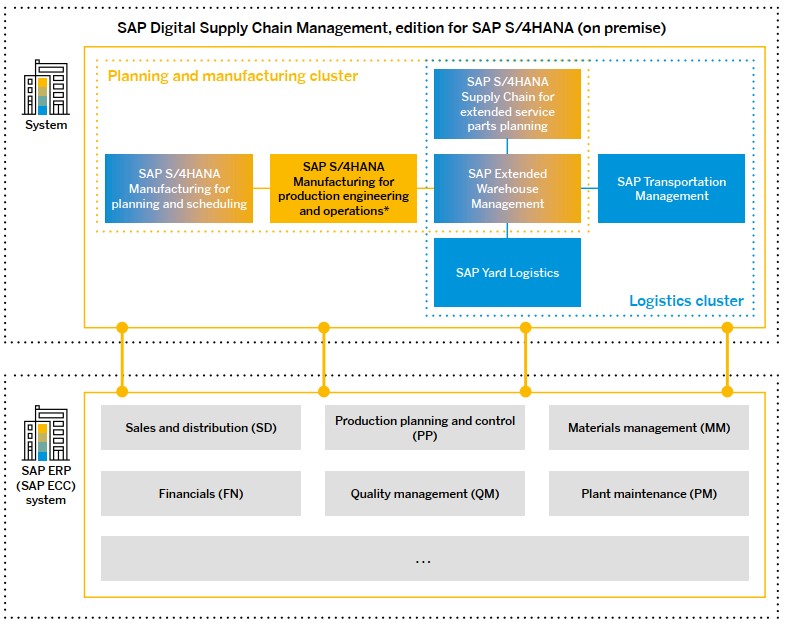
Now let’s check out what SAP TM offers to help you manage your transportation and shipment activities.
SAP TM: Objectives and Capabilities
SAP TM handles both inbound and outbound logistics. In inbound logistics, a manufacturer receives raw materials from the suppliers, whereas in outbound logistics, the manufacturer ships the finished goods to the customer’s location. Shipment planning, transport management, and freight cost settlement are part of both logistics processes.
Here are SAP TM’s main objectives:
- Deliver rightly-priced shipment to your customers on schedule and without damage.
- Give you complete and real-time visibility on your transportation system and, as a result, let you improve service.
- Address any disruptions instantly by identifying bottlenecks and problem areas proactively.
Functions and Process Flow of SAP TM
SAP TM starts the transportation management from order management and finishes with freight costing and settlement while generating analytics and reporting in every stage.

- Order management: The transportation activities begin with initiating a transportation requirement in the form of sales orders, purchase orders, or deliveries. SAP TM allows you to manage your transportation requirement in real-time through procure-to-pay (inbound), or order-to-cash (outbound) processes.
- Transportation planning: SAP TM allows you manual planning, optimized planning, and semi-automated planning at the planning stage, depending on your business needs. You can choose different mediums and aspects for your transportations, such as –
- Means of transport (rail, road, ocean, air, etc.)
- Career (you will also get actual career charges)
- Load distribution. (3-D visualization of container or truck)
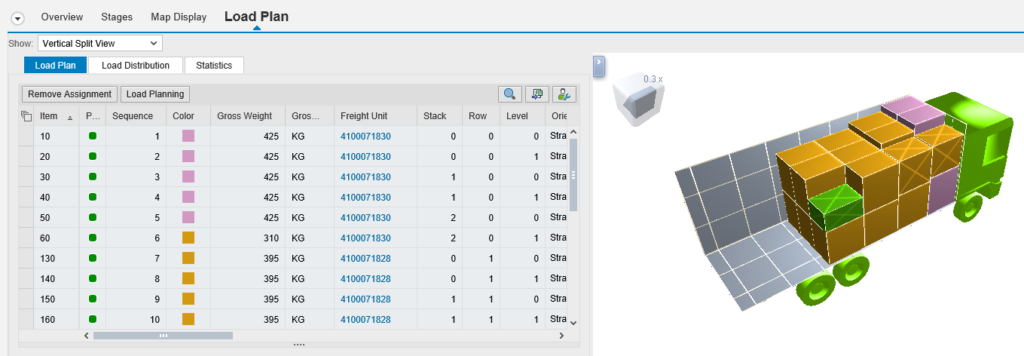
- Transport execution: After finalizing your plan, you can create deliveries and documents in the form of waybills. You can also monitor and manage your delivery events from the application windows, such as route planning. You can also integrate SAP TM with your warehouse management tools such as SAP EWM or Yard Logistics.
- Freight costing and settlement: Businesses that do not have their delivery service can use SAP TM for managing freight agreements and payments by creating freight orders. Calculation sheets and real-time rate charts will help you accurately compare the cost of using different freight services.
- Analytics and reporting: The real-time analytics and reporting functionalities are included in all the stages of SAP TM. Examples of some of the detailed information include:
- Import/Export, Dangerous Goods and Compliance,
- Document and Output Management,
- Location, transportation zones,
- Multimodal transportations,
- Ocean booking functionalities,
- Event-based charge calculations,
- Cost distribution, etc.
SAP TM, Embedded with SAP S/4HANA
The basic functionalities of SAP TM are now embedded with SAP S/4HANA, and the latest version is SAP S/4HANA TM 2021. The following diagram shows how SAP TM works in parallel with SAP Business Suite from the moment a sales or purchase order is created and serves all the transportation activities until the settlement or payment stage.
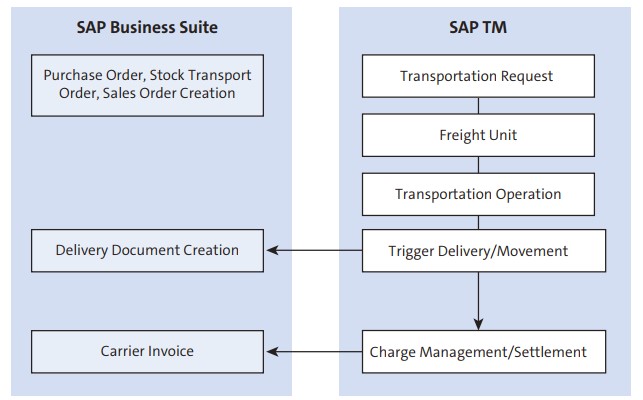
Here is a more simplified view of the process.
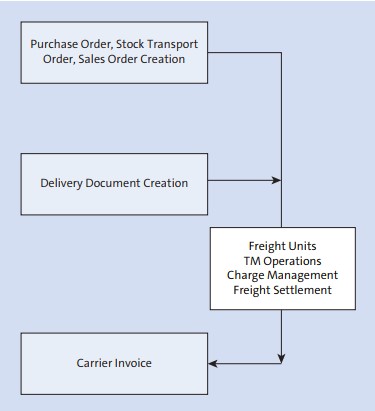
To facilitate this synchronization, SAP has simplified the master data maintenance system. In addition, the embedded system offers basic-level transportation management functionalities such as scheduling, transportation cockpit, and strategic freight management. The latest version also includes shipment planning with third-party shippers and freight-forwarding agencies.
SAP S/4HANA TM Practical Demonstration
We will briefly give you an idea of the SAP TM dashboard and demonstrate how you can practically use the SAP TM step-by-step. However, before the practical demonstration, let’s look at two essential components of transportation management – Freight Unit and Freight Order.
What is a Freight Unit?
A freight unit is a basic package or set of goods you will transport from one place to another. A freight unit must contain the exact delivery requirements. You can divide freight units based on the characteristics or weight of the goods.
What is Freight Order?
A freight order is the basic unit of shipment execution planning by a shipper or career. Freight order is used for cost collection and load management of vehicles. You can attach a freight unit to one or multiple freight orders (for multimodal transportation).
SAP TM: Step-by-step Tutorial
In our demonstration, we will use SAP S/4HANA TM 2020 to create 4 sales orders, 4 delivery documents, 4 freight units, and assign one freight order for all four freight units.
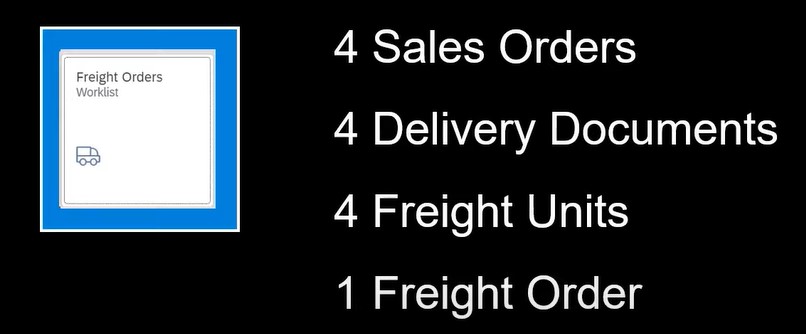
Step 1: Login through SAP Fiori launchpad.
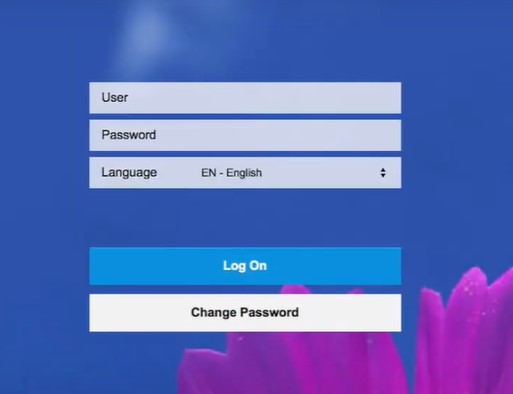
The application interface has navigation menus for analytics, order management, transportation planning, charge management, freight settlement, master data, and forwarding management. There are submenus for each of the main navigation menus.
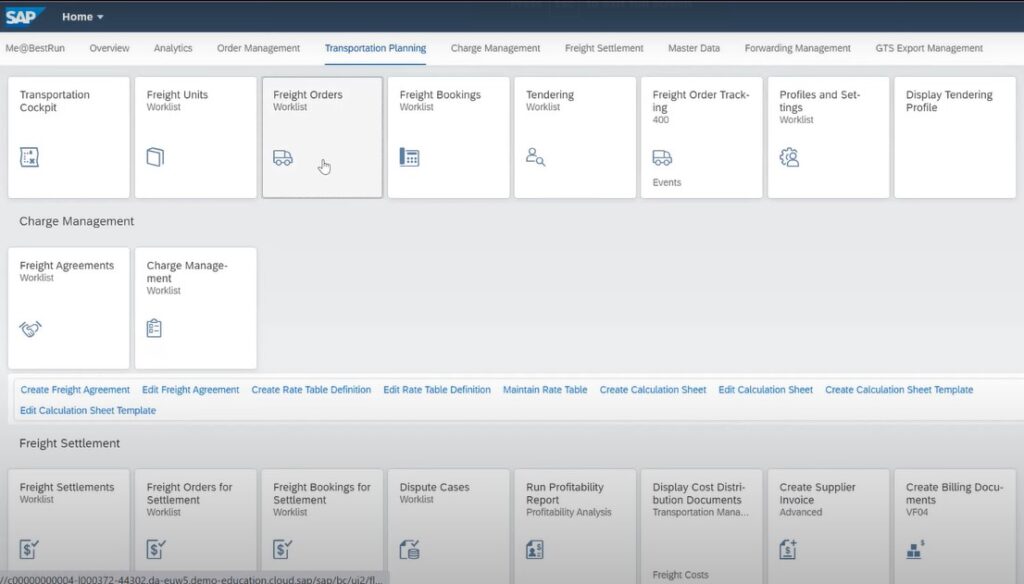
Step 3: Create sales orders for each customer.
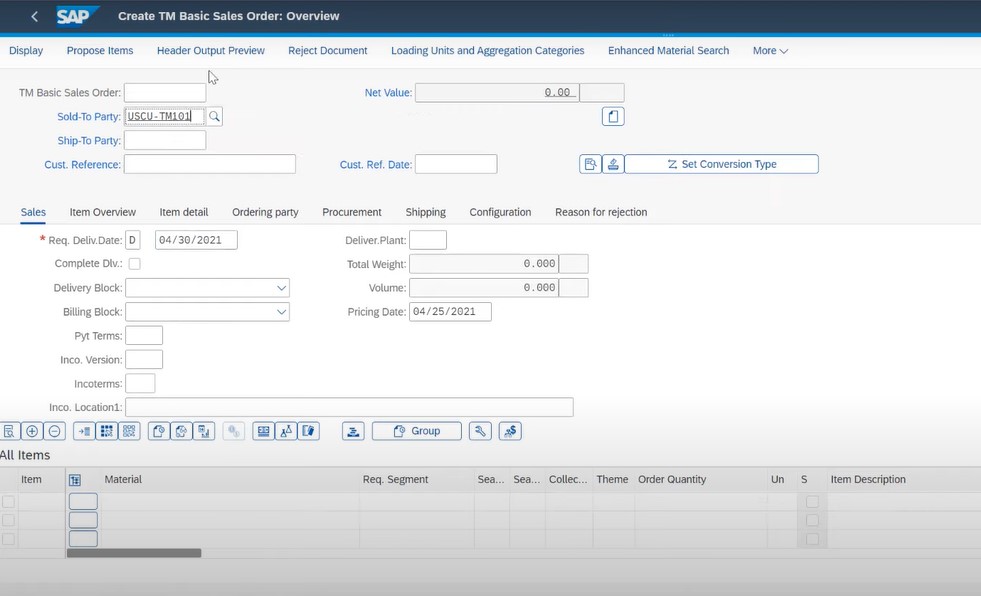
Step 4: The next task is to create outbound deliveries. Select all four of the sales orders to create four subsequent delivery documents.

Here are the delivery documents.
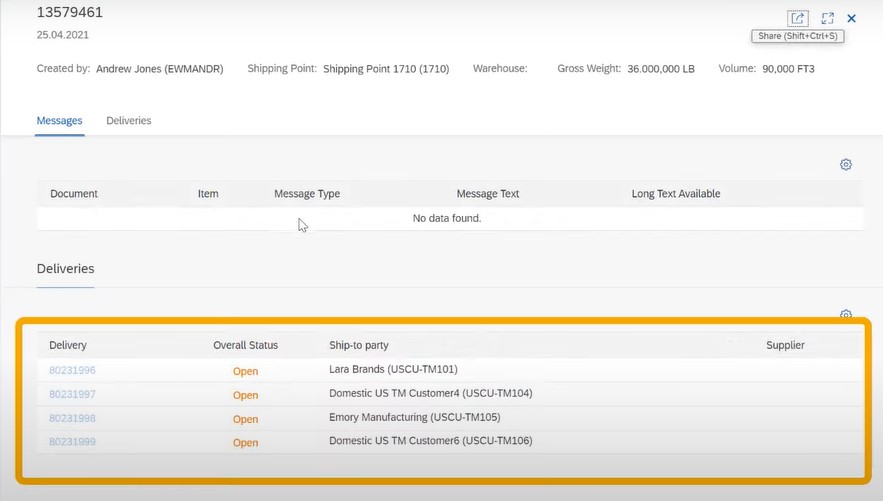
Step 5: Open the freight unit worklist and click freight units for manual planning.

Select all four freight units to combine them into one freight order.
Step 6: You will see the combined freight order in the documents tab.

Step 7: Select the sub-contracting query from the freight order worklist application, and the following window will appear.
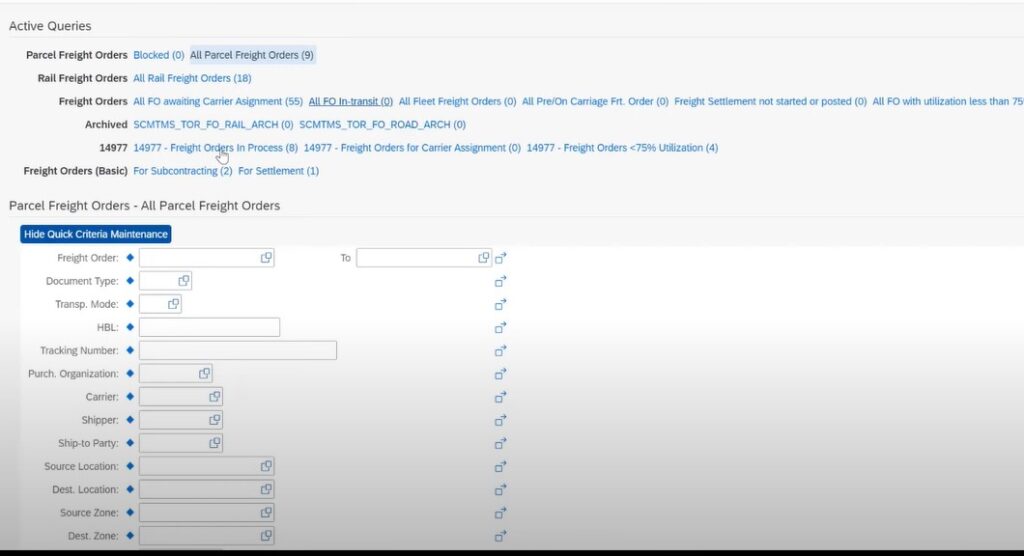
Step 8: Manually assign your preferred carier, and specify vehicle type. Save the order once you are done.
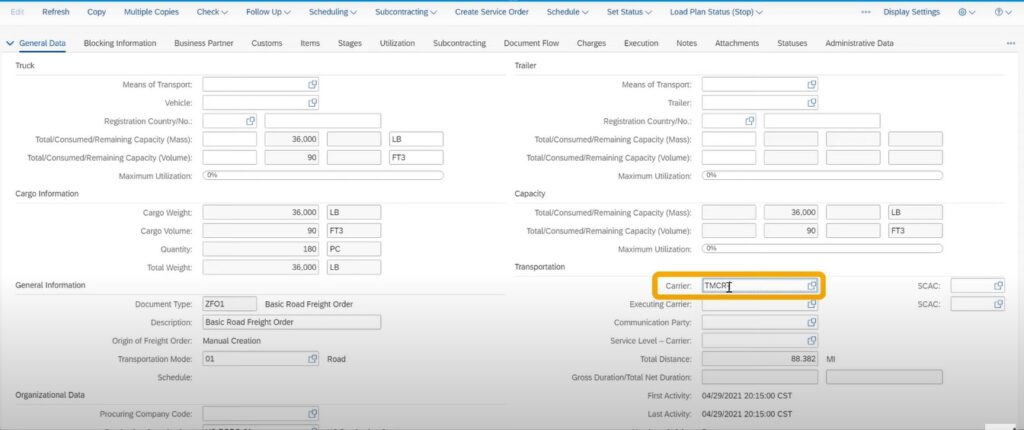
Step 9: For settlement, use the freight order worklist again by selecting FO settlement and your freight order.

Step 10: The next task is charge calculation.
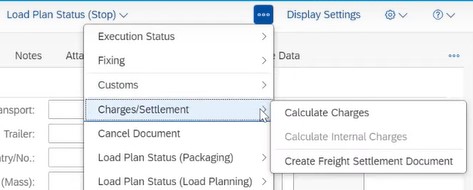
The cost calculation screen will display different cost elements, each with its rates and unit of measures.
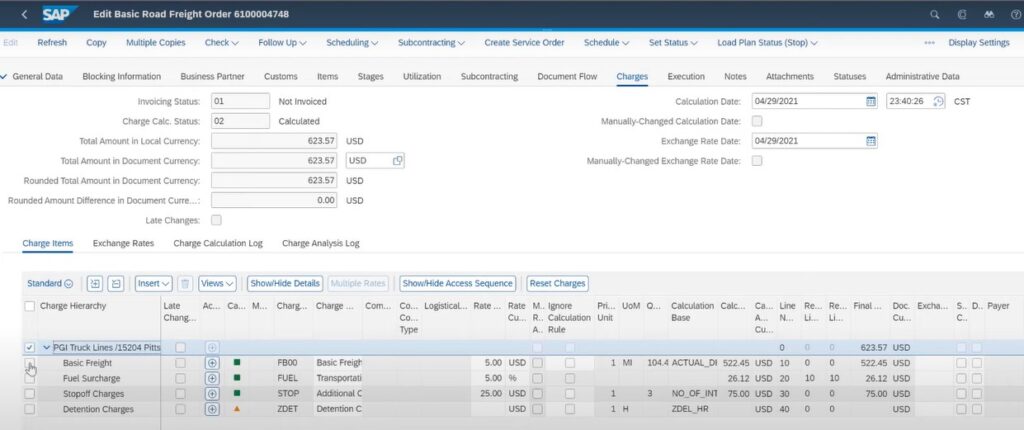
Step 11: Create a freight settlement document.

Step 12: Finally, use the supplier invoice application to create an invoice by entering relevant text codes.
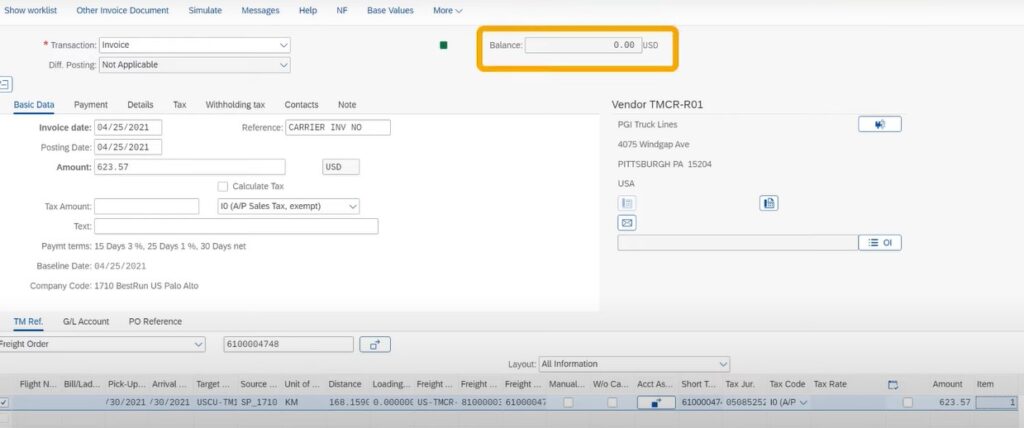
You will see that the invoice has been verified and settled toward cost accruals.

The functionalities shown in this demonstration are available on S/4HANA TM embedded, in both cloud and on-premise versions, and in S/4HANA TM decentralized version.
Now that you know the use cases and functionalities of SAP TM let’s explore the migration process.
How to Implement SAP TM?
Once you decide to implement SAP TM in your business, you have two practical options: Decentralized TM 9.6 or SAP TM embedded S/4HANA 2021. Although the versions have more than 95% similarity of the features, you can pick the suitable one depending on your business needs.
For example, TM 9.6 has a more detailed collaboration portal, charge management functionalities, and simulation-based on geo-locations than the embedded version. In contrast, SAP S/4HANA TM 2021 uses Fiori launchpad and embedded analytics, reducing your complexities and enabling a user-friendly interface.
Deployment Scenarios
Depending on your current business process and ERP tools, there are 4 probable scenarios for you to migrate to SAP S/4HANA TM or SAP TM.
Here are those:
- Scenario 1: SAP ECC to SAP TM
It is applicable for businesses using the older SAP ERP system and migrating to SAP TM.

- Scenario 2: S/4HANA to SAP TM
One of the most common scenarios when a customer wants to purchase the decentralized SAP TM license to work collaboratively with S/4HANA.
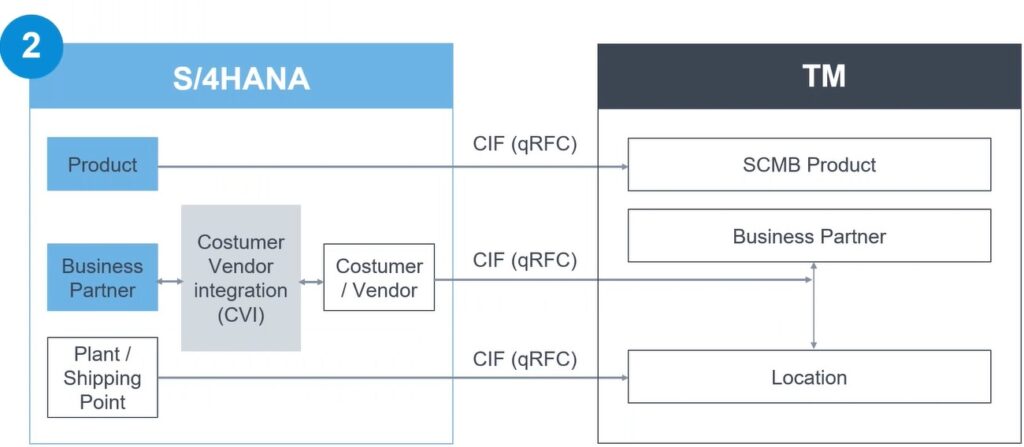
- Scenario 3: S/4HANA to S/4HANA TM
The migration process is relatively straightforward with a side-by-side scenario as the customer is already using S/4HANA and now wants to upgrade to S/4HANA TM.
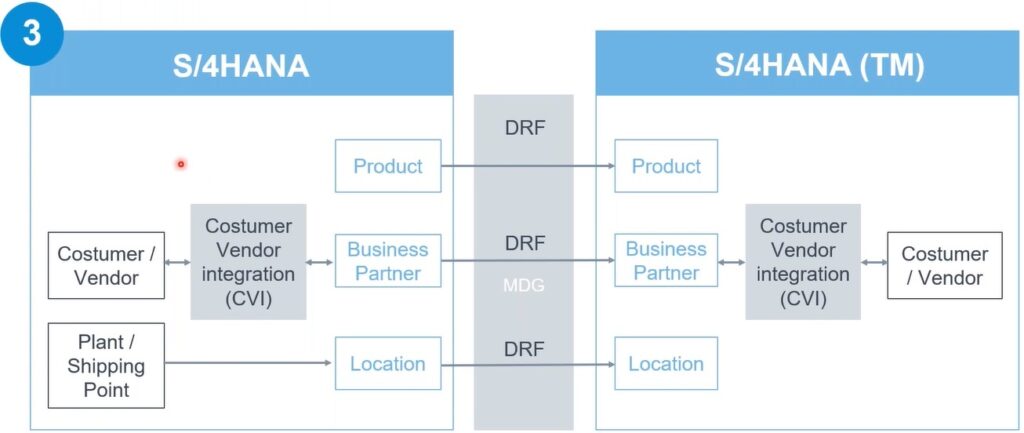
- Scenario 4: SAP ECC to S/4HANA TM
For businesses that have not yet converted to S/4HANA but want to try out the features of S/4HANA TM before a complete migration.
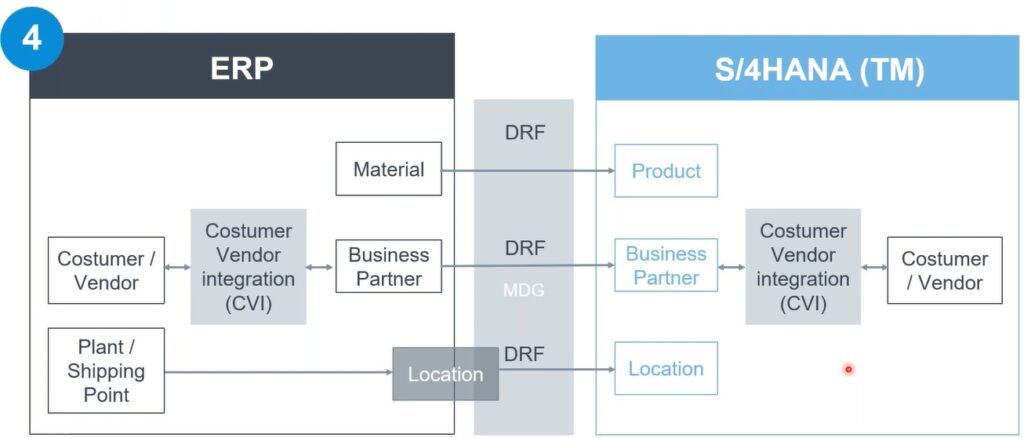
SAP TM Integration
SAP S4/HANA TM 9.6 FPS02 supports integration with the following SAP solutions out of the box:
- SAP ERP
- SAP EWM
- SAP Event Management
- SAP Global Trade Services
- SAP Ariba
To make the migration smooth for your business and ensure fluid integration, it is always a great idea to consult a certified SAP consultant to help you out.
Concluding Note
The global logistics industry size currently stands at 8.6 trillion USD, according to Statista. Transportation and shipment management are at the core of logistics. In today’s highly competitive business climate amidst political turmoils and economic sanctions, you constantly have to deal with supply chain problems and rising costs. The purpose of SAP S4/HANA TM is to make the overall transportation management process efficient for you by increasing visibility control levels through detailed planning and integration with other SAP solutions.
To work professionally with SAP TM in S4/HANA, make sure you check the relevant training and certification offered by SAP from beginner to advanced levels. After passing the certification exam, you can also be a certified SAP TM Application Associate.
- Overview of the Material Master in SAP S/4HANA - January 2, 2024
- SAP FICO TRANSACTION CODES (MOST COMMON) - December 24, 2023
- Best SAP S/4HANA MM Books for Beginners and Advanced Learners - November 25, 2023

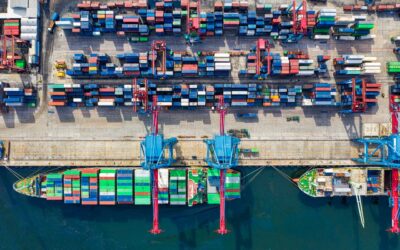


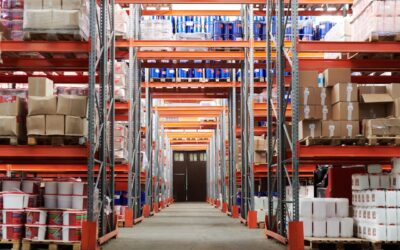
0 Comments